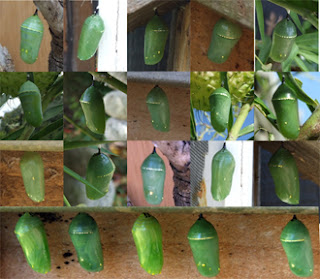My experience:
Although common enough in all except the coldest regions of New Zealand, Danaus plexippus is not a native species but seemingly self-introduced at some point within the last 150 years. It's large size and colourful wing markings have led to its popularity in art and science. I've seen paintings, collages, sculptures and jewellery utilising its patterns, which contrast vividly with New Zealand's predominantly green appearance.Swan plants, the almost sole food source, are readily available from garden centres and buying one can lead to large numbers of self-seeded plants, aiding the spread of the monarch. I've found this year that even young plants under 50cm tall have had eggs laid on them. I've also noticed that the swan plants in my back garden contain more than double the number of caterpillars than those in the front garden, despite the latter garden being much larger and having a lot more vegetation. I've even noticed that some caterpillars in the front garden disappear shortly after starting to pupate; perhaps the denser planting attracts or hides more predators?
Lifecycle:
The eggs are usually found on the underside of leaves and tend to be more conspicuous than the first instar (freshly-hatched) caterpillars. Apparently, larger caterpillars will munch through both eggs and smaller caterpillars without noticing, so it's a monarch-eat-monarch world out there! I've had to move some caterpillars when they get to a decent size in order to prevent them eating their entire plant and starving to death. Females can lay hundreds of eggs in their lifetime at a rate of up to 40 per day, so monarch care sites recommend destroying later eggs to allow the earlier individuals to survive. In general, the warmer the weather the quicker the caterpillars grown to full size before pupating. However, it has been noted that butterflies that hatch in the autumn can survive over winter, often in colonies, their lifespan extended from two months for same-summer breeders up to nine months. Unlike in their North American homeland, New Zealand monarchs do not migrate enormous distances.Predation:
Despite absorbing toxins from milkweed, both caterpillars and butterflies are predated by a range of other animals. I've occasionally found a pair of wings on the ground, which is a good indication of predation by a South African praying mantis, Miomantis caffra. Other introduced invertebrates such as wasps will also attack monarchs. It's interesting that these predators tend to have originated in Europe, Africa and Asia yet the monarch evolved in North America; clearly, the former aren't too specialised to be able to handle alien prey. Which of course is what has happened in general to New Zealand's native birds and reptiles, with European mustelids and rodents and Australian possums finding a veritable feast amongst the kiwi and company.Caring for monarchs:
Apart from removing caterpillars from overcrowded plants, my only other assistance is to rehang any fallen chrysalis and move the occasional pre-pupating wanderer into a wood and wire cage until they metamorphose. Although I have found one chrysalis about eight metres from the closest swan plant, a fully-grown wandering caterpillar might just prove too tempting a morsel. Otherwise I tend to leave nature to do its thing; after all, it's hardly an endangered species. Many caterpillars disappear before reaching pupation due to a combination of disease and predation and any swan plant that gets completely eaten may lead the incumbent caterpillars to starvation. Darwin was famously inspired by Thomas Malthus' An Essay on the Principle of Population, so it's great to be able to see such a theory in action in your own garden!Public interest:
Despite being neither native nor endangered, there are various New Zealand-based citizen science projects studying them, such as by fitting wing tags for tracking purposes. Much as I am in favour of direct public engagement in science, I wonder if the effort wouldn't be better redirected towards endangered native species. As I've previously discussed, if visually attractive poster species get much of the attention, where does that leave the smaller, more drab, less conspicuous critters that may be more important?I'm still at a loss to what has caused this summer's proliferation of monarch butterflies in my garden. There are just as many other summer species as usual, such as adult cicada and black crickets, and seemingly as many monarch predators such as praying mantises. But as I've mentioned before, perhaps what to human eyes appear similar conditions are not so to these colourful creatures. Although how much effort would be required to detail those conditions is somewhat beyond the capability of this amateur entomologist!








